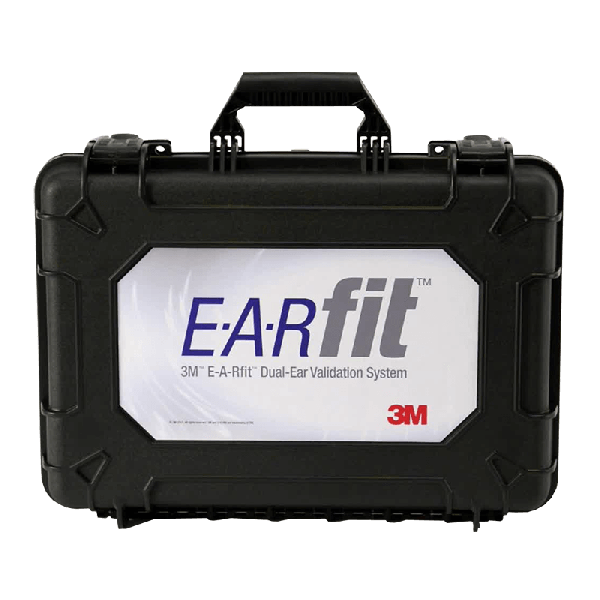Yes, Air-Met Scientific offers hearing fit testing equipment for short and long-term rental and for sale. A hearing fit tester provides a real-world measurement of the level of noise reduction a worker receives from their hearing protection device (HPD). These devices can conduct an assessment of the effectiveness of the HPD and determine if it meets Australian safety regulations. To facilitate compliance reporting, certain hearing protection fit testers, like the 3M E-A-Rfit Validation System, are equipped to generate digitalised automated reports for added convenience.Contact your local Ai-Met Scientific office to discuss your hearing fit testing requirements.
Hearing protection fit testing is the process of assessing and ensuring the effectiveness of personal protective equipment worn by workers. Conducting a hearing fit test determines if the hearing protection device provides adequate level of hearing protection and ensures they are correctly and comfortably fitted to each worker.
Properly fitted hearing protection is crucial in maintaining a safe work environment. If the fit is inadequate, workers will be exposed to harmful noise levels, risking hearing damage. Conversely, overprotection can lead to excessive noise reduction which can prevent workers to hear important signals or warnings. Regular fit testing help address these issues and ensures that each worker received the appropriate level of hearing protection.
Hearing protection fit testing verifies the effectiveness of hearing protection equipment worn by the worker and ensures they have adequate level of protection against loud occupational noises. A critical component of a comprehensive hearing protection program, fit testing can help employers to significantly reduce noise-induced hearing loss, creating a safer and more comfortable work environment for workers.
Factors why fit testing is important include:
- Ensuring the proper wear of hearing protection equipment - Fit testing ensures hearing protection devices such as earplugs or earmuffs are worn correctly and provide the intended level of protection. If these devices do not fit properly, they may not effectively reduce occupational noise exposure leading to noise-induced hearing loss.
- Individualised protection for workers - People have different ear shapes and sizes, so one size does not fit all. Fit testing allows for individualised solutions, ensuring that each person gets the right type and size of hearing protection that fits comfortably and securely.
- Compliance with regulations - Regulations and standards have been established to safeguard workers against undue exposure to noise. Conducting fit testing enables organisations to showcase adherence to these guidelines, thereby minimising the likelihood of facing legal and financial consequences.
- Promotion of health and safety in the workplace - Noise-induced hearing loss is a serious occupational health concern. By ensuring that employees have properly fitted hearing protection, organisations can reduce the risk of long-term hearing damage and related health issues among their workers.
- Improved comfort and wearability - Comfort is a critical factor in hearing protection usage. If hearing protection is uncomfortable, workers may be less likely to wear it consistently. Fit testing can identify and address comfort issues, increasing the likelihood that employees will use their hearing protection as intended.
Yes, training is typically required to use a hearing protection fit testing equipment. The specific training might vary depending on the fit testing equipment being used. Individuals conducting a hearing fit testing should know how to interpret the results to identify a proper fit and recognise when to make adjustments to the hearing protection equipment. They should also maintain records of the hearing fit test results for compliance and evaluation of the fit test program.
Hearing protection equipment should be calibrated and inspected regularly to ensure its effectiveness. Manufacturers often provide specific instructions on how often their hearing protection equipment should be inspected and any maintenance procedures that should be followed. As a guide, a calibration should be conducted every two years by a qualified technician. However, visual checks for wear and damage should be conducted before each use.
Contact your local Air-Met Service Centre for more information about service and calibrations.
Several factors need to be taken into consideration to ensure the device is suitable for individual requirements. These factors include:
- Noise exposure level - Select a hearing protection device that is suitable for the level of noise in the environment. A sound level meter can help identify and determine the level of noise at a worksite.
- Noise reduction rating (NRR) - Hearing protection devices are often rated with an NRR, which indicates their ability to reduce noise. The higher the NRR, the greater the noise reduction. Be sure to choose a device with an NRR that matches the noise levels you will encounter.
- Type of noise - Consider the characteristics of the noise in your environment. Is it continuous, impulsive, or intermittent? Different hearing protection devices may be more suitable for different types of noise. For example, earmuffs are better at blocking out continuous noise, while earplugs are effective against impulsive noise.
- Comfort and fit - The hearing protection device should be comfortable to wear for extended periods. It should also be compatible to wear with other PPE such as eye protective gear and helmets.
- Regulation and standards - Ensure the hearing protection device meets the regulatory standards in is fit for use for a particular work task.

